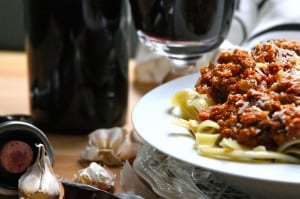What is it about the mouth-watering food of Bologna that makes foreigners want to massacre it?

I adore Mortadella – who doesn’t? But I wouldn’t eat Doktorskaya Kolbasa or Oscar Myer boloney – those Russian and American perverted version of the delicacy — for love or money. Why does “baloney” in America, said sarcastically mean “nonsense”?
Spag bol has had a very bum rap. It appears on the tables of students or the newly graduated as hamburger fried up with very inferior bottled tomato sauce. It’s the staple of bad Italian restaurants the world over. We associate it with “fast” “easy” and “cheap.” Real Spaghetti Bolognese is anything but. It’s a complex blend of aromatics, vegetables, and meat, melded together with tomatoes and milk for a lengthy “low and slow” cooking that produces a velvety “melt-in-your mouth” texture and flavor.
The Moscovore family likes spag bol, so when I make it, I make a lot of it, and I freeze a whole bunch. I’ve developed this recipe over a number of years from various sources. Marcella Hazan, of course, is the Italian food guru, and I began my exploration with her recipe in “The Essentials of Classic Italian Cooking” but I was intrigued by a recent article in Cook’s Illustrated that told us to lose the dairy (I’m skeptical) but to add a lot of sage, which turned out to be a wonderful flavor to introduce to this delightful sauce.
As the Moms out there scan the list of ingredients, they’ll be dancing the fandango: Spaghetti Bolognese sauce is a superb place to hide carrots. Lots and lots of carrots. By the time the sauce is done, they’ve cooked down to a sweet and delectably soft state where they are hard to detect and hard to resist.
Some of the original ingredients of Spaghetti Bolognese are a little hard to find in Moscow, such as pancetta. I’ve substituted Warren’s English Bacon, which seems to do a great job. Veal is not always easy to find, so Mr. Warren to the rescue again – his pork and sage sausages, released from their casings and fried up do a yeoman service.
A final note: “Spag Bol” is actually “Tag Bol” as a recent article I read pointed out. The Bolognese never serve it with long, thin noodles, but rather the thicker, flat ones. I’ve also seen recipes, which encourage chefs to try the shorter, tubular pastas such as penne or rotini. They seem to work very well, offering convenient nooks and crannies for the delectable sauce to linger in. Lovely!
Ragu Bolognese
Ingredients
- 1 large red onion (diced finely)
- 4 celery ribs (finely diced)
- 3 carrots (peeled and finely diced)
- 250 g (9 oz) bacon (sliced and diced into small “lardons”)
- 350 g (3/4 lb) ground beef (mince)
- 4 pork and sage sausages (remove the casing and slide the meat out.)
- 100 g (1/4-cup) chicken livers (this is an optional ingredient, and not everyone loves grappling with chicken livers, but they are worth the slime for the velvety texture they add, as well as the flavor. Once you have cleaned them, put them into a food processor, fitted with a steel blade and pulse 6 times to break them down. )
- 400 ml (1-2/3 cups) Canned tomatoes, diced with their juice
- 250 ml (1 cup) whole milk
- 250 ml (1 cup) dry white wine
- 250 ml (1 cup) chicken stock
- 30 ml (2 Tbl) nutmeg
- 30 ml (2 Tbl) fresh sage (stems removed, finely chopped)
- 45 ml (3 Tbl) butter
- 15 ml (1 Tbl) olive oil
- coarse sea salt
- fresh ground pepper
Directions
- Prep the vegetables and meat. Set a heavy-bottomed Dutch Oven or the stoneware of a slow cooker on moderate heat. Melt the butter and olive oil until the mixture begins to bubble. Add the onion, and saute until the onions become see-through and soft. Add the celery and carrot, and cook, stirring to combine, for 3 minutes.
- Add the bacon lardons and toss until they begin to sweat and curl at the edges. Then, add the meat and sausage and use the back of a wooden spoon to separate into smaller pieces. Salt the meat with a pinch of the coarse sea salt. Cook for 4 minutes, then add the chicken livers. Cook a further 3 minutes until the beef is browned all over and the chicken livers have gone from chocolate brown to a pinky-grey.
- Pour in the milk, reduce heat and stir to combine the onion/meat mixture with the milk. Keep a sharp eye on it as it simmers. When about half of the milk is absorbed, add one of the tablespoons of nutmeg to the mixture.
- When the milk is completely absorbed, add the wine and stir until the wine, in its turn, has completely evaporated. Then add the tomatoes. Stir to combine all the ingredients thoroughly. Add the chopped sage.
- It is now time to go to the “slow and low” part of the process, when you can walk away from the sauce for all but the occasional stir. You can bake the sauce, covered, in the oven at 150C or 300F (Gas Mark 2) for 3-4 hours. You can simmer it on top of the stove, pot lid slightly ajar under a very weak flame to ensure that the sauce does not rise above what Marcella calls, “the laziest of simmers,” (I love that) also for 3-4 hours. In a slow cooker, 5-6 hours on low will achieve the results. You are looking for all of the moisture to disappear at the end of the “slow and low” process, but not before the end. If the mixture dries out, use the chicken stock to reintroduce liquid. Stir occasionally.
- If you are serving immediately: keep the sauce warm while you cook the pasta. Be sure to salt the pasta water with a generous pinch of salt. Cook until just shy of al dente (still chewy and not sticking to the kitchen wall when you hurl it towards it) When you are ready to drain the pasta, keep back a cup or coffee mug full of the pasta water. Drain the pasta. Place a deep saute pan or Dutch oven onto moderate heat. Add the pasta water, and when it simmers, add the drained pasta and stir to coat. Add the sauce to the proportions you desire and then toss with a pair of tongs.
- Garnish with freshly grated cheese and serve immediately.
Note:
If you don’t plan to serve the pasta sauce immediately, allow it to cool to room temperature and then refrigerate, covered, for up to 2 days. To freeze, allow to cool to room temperature then pack into zip lock plastic bags, which you can then flatten and stack. Always make more than you think you’ll need: it is great for the next few days or you can repurpose it in a lasagna.
|
Serve, and enjoy










2 Comments